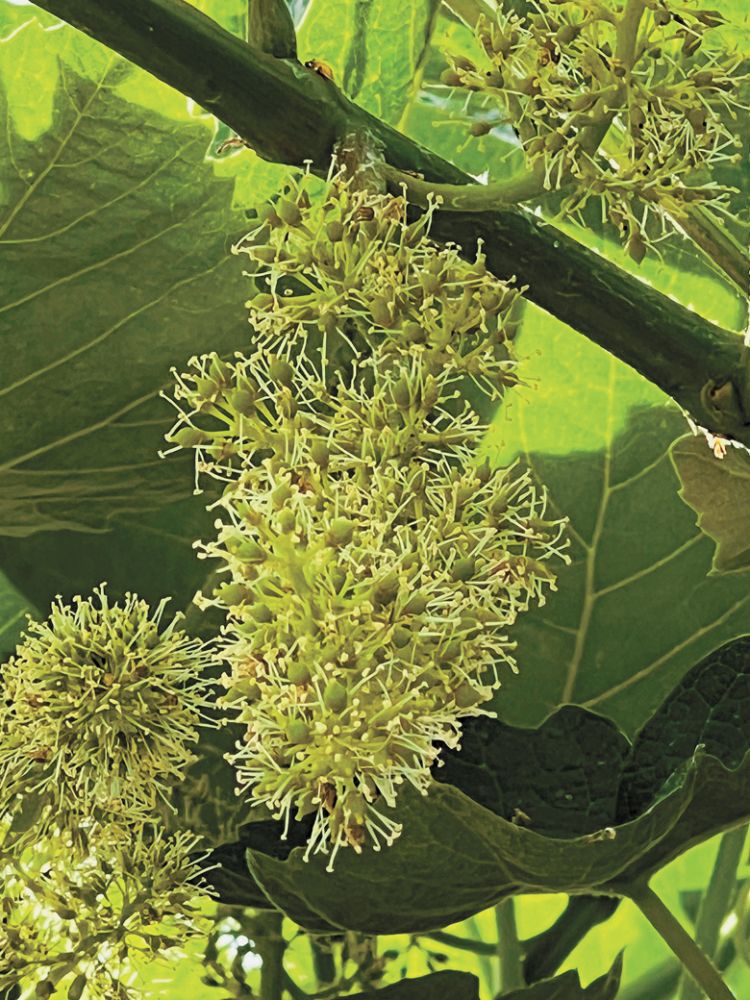Weather, Climate and Wine: Bloom Boom
Grape flowering occurred during favorable weather

By DR. GREG JONES
Well, it has been the second cool and wet spring in a row for Oregon. While grapevines throughout the state experienced budbreak a couple weeks later than average, fortunately this year, we didn’t experience a late frost like last vintage.
The cool spring seemingly headed right into summer with a mid-May heat wave. From time to time, the Pacific Northwest gets early season heat waves like this year, with record-breaking temperatures in the 90s across Washington and Oregon, even up into Canada’s British Columbia and Alberta. The vines loved the warmth and grew rapidly, trying to catch up from their late start.
Over the last few weeks, flowering has occurred in vineyards throughout Oregon. Grapevine flowers are quite small and hard to see unless one is up close to the vines, but the process is beautiful. Grapevines are hermaphroditic, in other words each flower has both male (stamens) and female (pistil) organs. Grapevines are largely self-pollinators due to the structure of the flowering parts, where a closed “cap” sits over the stamens and pistil facilitating the fertilization. As they blossom, the cap falls off and the individual flowers are largely fertilized.
Generally, flowering takes place within six to eight weeks of budbreak; typically, in May to early July, depending on vineyard location, the grape variety and weather. In Oregon, we tend to average early to mid-June for flowering. The bloom period usually lasts one to three weeks, depending on the same factors.
Since flowering leads to fruit set and thus potential yield of the crop, the weather during this period is crucial to production. Ideally, during flowering, growers hope for conditions that are not too hot, not too cold, little to no rain with light winds and plenty of sunshine while there is still moisture in the soil.
If there is too much cloud cover, wind, and rain during flowering, the fertilization of the flowers can be hindered. Called “coulure,” the French word for shatter, it’s when unfertilized berries drop from the cluster. Poor fertilization can also lead to “shot” berries that typically don’t have seeds and tend to stay small through harvest. The French term for this is “millerandage,” often referred to as “hens and chicks,” where berry sizes on a cluster widely vary, with the hen berries containing seeds, due to normal fruit set.
While the focus during flowering is on fertilization and berry set, grapevines are also establishing potential yields for the next vintage. They develop “latent buds” that form in the leaf axil, the surface connection between the leaf stalk (or petiole) and the shoot or cane. During late spring, these latent buds form the primordia, or groups of cells, of the flowers and leaves for shoots that grow the following season. So, the spring weather can be doubly important, impacting the current vintage and next year’s potential growth.
It appears that the weather during the flowering period this year was favorable for production. Flowering also sets the clock for harvest. The general rule is that it takes 100-110 days from bloom to when the fruit is ripe and ready to pick. As the season proceeds over the next few months, managing the vines to carry the crop through the harvest becomes the focus of growers everywhere. While there are numerous management activities still to be done in the vineyards, growers are keeping an eye on the weather. The hope now is for warm temperatures with few, if any, heat spikes and low rainfall, especially late in the season.
Year after year, Oregon’s climate contributes to our celebrated vintage variation. WEATHER, CLIMATE AND WINE explains how the weather affects our grapevines, fruit and, ultimately, wines. Visit www.climateofwine.com to read more in-depth reports.










